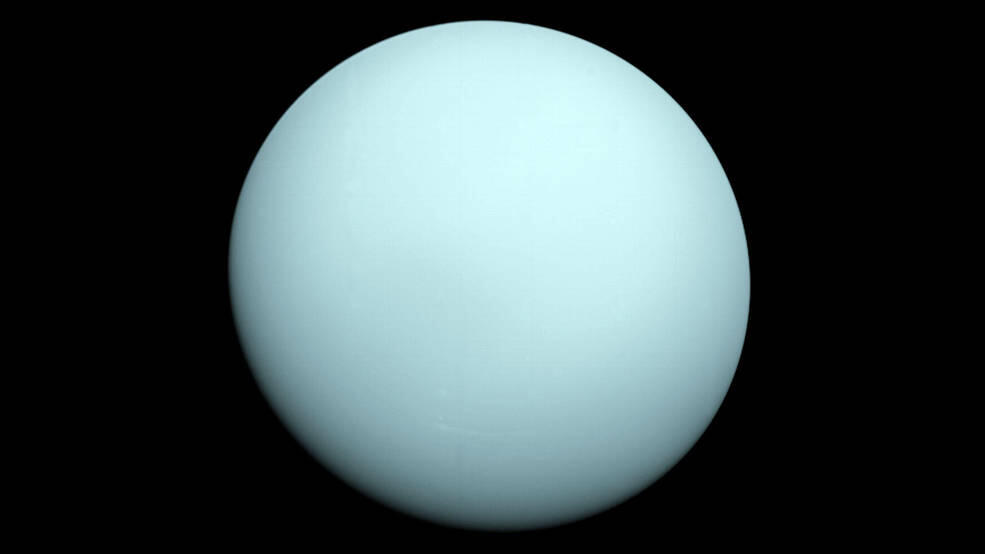Getting your Trinity Audio player ready...
For decades, Uranus was regarded as an oddity within our solar system due to the unusual phenomena detected in its magnetic field during the planet’s only spacecraft encounter in 1986.
A new study suggests that Uranus’s magnetic field may not be as peculiar as previously thought, indicating that the earlier findings may not accurately represent the planet’s typical magnetic behavior. Voyager 2 may have simply recorded the magnetic field on an atypical day during its 1986 flyby of Uranus.
3 View gallery


Planet Uranus and its rings, as seen by the James Webb Space Telescope
(Photo: NASA, ESA, CSA, STScI)
A single strange observation
Nearly all of our knowledge about the two outermost planets in our solar system, Uranus and Neptune, comes from data collected by the only spacecraft to pass by them: NASA’s Voyager 2. In January 1986, Voyager 2 flew approximately 80,000 kilometers from Uranus before continuing its journey to Neptune, which it reached in the summer of 1989.
The images and measurements taken near Uranus revealed a surprising detail about the seventh planet from the Sun. It was already known that Uranus possesses magnetic radiation belts that protect it from the solar wind—the stream of charged particles emitted by the Sun, similar to Earth’s Van Allen belts.
However, during Voyager’s flyby, it became evident that this magnetic belt—the magnetosphere—was quite different from what researchers expected: it contained almost no plasma or solar wind-charged particles, except for an inner belt of electrons. The magnetic field was also smaller than anticipated in terms of its distance from Uranus’s surface, tilted relative to the planet’s rotation axis, and asymmetrical.
These findings led to Uranus being classified as a planet with an unusual magnetic field, prompting many scientists to develop various theories to explain these puzzling characteristics. The findings also suggested that the five major moons of Uranus are geologically inactive, despite previous estimates that they are relatively young and contain ice.
3 View gallery


The solar wind swept away Uranus’s plasma and altered the shape of its magnetosphere. The planet’s typical state (left) compared to its state during the solar storm at the time of Voyager 2’s flyby
(Illustration: NASA/JPL-Caltech)
If the moons were active, it would be expected that materials emitted from them, primarily water vapor, would feed into the particle belt that researchers anticipated finding around the planet.
Gone with the [solar] wind
In a new study, a team of scientists led by researchers from NASA's Jet Propulsion Laboratory (JPL)—the organization that built and operates the Voyager spacecraft—reexamined data collected by Voyager 2 during its flyby of Uranus 38 years ago. Their conclusion was that Voyager 2 simply observed the planet on an unusual day.
The researchers explain that the likely cause of this anomaly was a strong solar wind storm that reached Uranus shortly before Voyager’s flyby. Such solar storms result from intense activity on the Sun, leading to the emission of powerful particle streams.
These storms can pose risks to satellites positioned around Earth, particularly those in high orbits beyond the protective Van Allen belts, and in extreme cases, may even disrupt electrical or communication infrastructure on Earth.
This is likely what happened to Uranus just before Voyager 2 recorded its data. The intense burst of solar radiation compressed Uranus’s magnetosphere, swept away the charged particles researchers expected to find, and shifted it off Uranus’s rotational axis. “If Voyager 2 had arrived just a few days earlier, it would have observed a completely different magnetosphere at Uranus,” said Jamie Jasinski of JPL, lead author of the study. “The spacecraft saw Uranus in conditions that only occur about 4% of the time.”
Dreams of water
The new findings may bring good news for those searching for habitable environments within our solar system. If the researchers' hypothesis holds true, Uranus's large moons - Miranda, Ariel, Umbriel, Titania, and Oberon - could indeed be geologically active. Geological activity within these moons might generate heat through rock movement, potentially allowing liquid water to exist beneath their outer ice layers.
Get the Ynetnews app on your smartphone: Google Play: https://bit.ly/4eJ37pE | Apple App Store: https://bit.ly/3ZL7iNv
Researchers estimate that there are several "water worlds" in the solar system, including Enceladus, one of Saturn’s moons, and Europa, one of Jupiter’s largest moons. Confirming this hypothesis is one of the main goals of NASA’s Europa Clipper mission, launched this past summer to study Jupiter's moon.
“The flyby was packed with surprises, and we were searching for an explanation of its unusual behavior. The magnetosphere Voyager 2 measured was only a snapshot in time,” said Linda Spilker of JPL, who was among the Voyager 2 mission scientists analyzing the spacecraft’s findings during the Uranus flyby in 1986, who was not involved in the current study. “This new work explains some of the apparent contradictions, and it will change our view of Uranus once again.”


